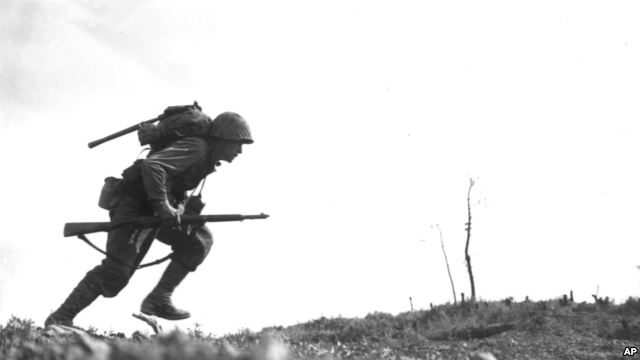VOA慢速英语:纪念二战结束70周年
The allies fought many costly battles against Japan. The bloodiest and most deadly was the Battle of Okinawa. U.S. officials said the battle was one reason they decided to use atomic weapons on Japan. They said the human cost of fighting was too high.
 |
|
Pfc. Paul Ison, a U.S. Marine runs through Japanese gunfire on Okinawa, May 10, 1945. |
VOA recently visited the island of Okinawa to learn more about the effects of the war there.
The invasion of Okinawa was the last, the bloodiest, and one of the largest battles of World War II. More than 1,000 American ships and hundreds of thousands of troops were involved. The fighting lasted 82 days. Villages were destroyed and forests burned. Almost 200,000 people were killed.
A small museum on a U.S. Marine base in Okinawa shows pictures and historical objects from the battle. Mark Waycaster is the curator of the museum's Battle of Okinawa area. He says Japanese General Mitsuru Ushijima's plan was to hurt the morale and strength of the Americans. His goal was not to win.
"His intentions is to bleed the American forces so bad that the United States sues for peace."
Many American and Japanese troops were killed or injured in Okinawa. Japanese forces fought fiercely. Some fought to the death, refusing to surrender even when they knew they could not win. This was one reason U.S. officials gave for their decision to drop atomic bombs on the city of Nagasaki and Hiroshima.
Today on Okinawa, many Japanese still remember the battle. The fighting caused the deaths of almost one-third of the civilians who lived on the island. Some Japanese military areas are preserved as memorials.
The Himeyuri Peace Museum tells the story of about 200 Japanese schoolgirls. They were forced to work as medical aides for the Japanese military. Many died in the fighting.
Shimabukuro Yoshiko was seriously injured during the fighting. She said Japanese officials warned the girls that the Americans would rape and then kill them. She says she was told American soldiers were devils. But she said an American soldier saved her life.
She says "I saw the soldier's face and he looked nice and said 'I'm going to help you.'"
Many people remember or learned about the deaths and damage resulting from the war. Many Okinawans are pacifists, and they gather often to speak against violence.
They are unhappy about the presence of American troops on Okinawa. And they oppose efforts by conservatives in Japan to strengthen the country's military.
I'm Christopher Jones-Cruise.
VOA's Brian Padden reported this story from Okinawa, Japan. Christopher Jones-Cruise adapted it into Learning English. George Grow was the editor.
______________________________________________________________
Words in This Story
curator– n. a keeper or caretaker for a museum collection
sue for peace– v. formal to officially ask for an end to fighting
preserve(d)– v. to keep safe from loss or harm
pacifist– n. someone who believes that war and violence are wrong and who refuses to take part in or support a war effort
- 频道推荐
- |
- 全站推荐
- 推荐下载
- 网站推荐




















